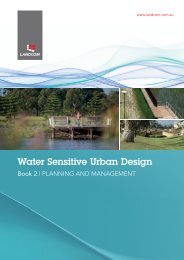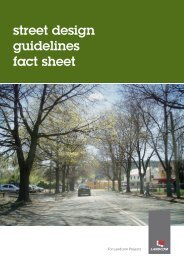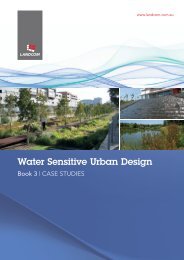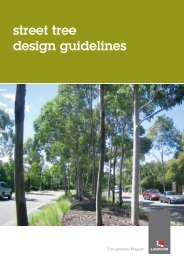Landcom Book 4 Maintenance - WSUD
Landcom Book 4 Maintenance - WSUD
Landcom Book 4 Maintenance - WSUD
Create successful ePaper yourself
Turn your PDF publications into a flip-book with our unique Google optimized e-Paper software.
Water Sensitive Urban Design<br />
Item to be<br />
Monitored<br />
Purpose of<br />
Monitoring<br />
Performance<br />
Target<br />
Schedule<br />
<strong>Maintenance</strong> or<br />
Investigation<br />
Immediate<br />
Action Required<br />
<strong>Maintenance</strong><br />
Action Required<br />
Plant<br />
Condition<br />
Plants are crucial to the performance<br />
of a bioretention system.<br />
Healthy vegetation<br />
Poorly growing or<br />
visibly stressed<br />
Die back / dead<br />
plants<br />
Schedule an investigation into the<br />
cause of plant die-back or poor health.<br />
During dry periods: Plants help<br />
maintain the structure and porosity of<br />
the filter media.<br />
During rainfall events: Vegetation<br />
aboveground acts to retard and<br />
distribute flows, and provides scour<br />
protection if the bioretention system<br />
is designed as a swale. Below ground<br />
the roots provide an important media<br />
for trapping or absorbing pollutants as<br />
they percolate through the media.<br />
<strong>Maintenance</strong> action will depend on the<br />
cause of die-back or poor plant health.<br />
Once the problem is rectified, infill<br />
planting may be required, especially if<br />
more than 1 square meter of plantings<br />
has died. Infill planting must be as per<br />
the original planting schedule.<br />
The accumulation of dead plant<br />
material can detract from the visual<br />
amenity of the bioretention system.<br />
Litter<br />
(organic)<br />
Organic litter can provide an additional<br />
source of nutrients to the bioretention<br />
system, introduce non-native species,<br />
which out-compete native plants and<br />
block the filter media.<br />
Accumulated organic matter / litter<br />
can also cause offensive odours<br />
(such as methane gas and hydrogen<br />
sulphide, i.e. rotten egg gas) and can<br />
reduce percolation of water into the<br />
filter media.<br />
No litter visible Litter visible Litter thickly covers<br />
filter media surface or<br />
detracting from visual<br />
amenity<br />
Identify source of organic litter and<br />
address with appropriate response<br />
action: e.g. change of landscape<br />
maintenance practices; community<br />
education re: litter dumping<br />
(appropriate for repeat incidences).<br />
In the interim, all litter must be<br />
removed by maintenance crews.<br />
Litter<br />
(anthropogenic)<br />
Litter can potentially block the<br />
inlet and outlet structures of the<br />
bioretention system resulting in<br />
flooding, as well as detract from the<br />
system’s visual amenity.<br />
No litter visible Litter visible Litter blocking<br />
structures or<br />
detracting from visual<br />
amenity<br />
Identify source of rubbish: e.g. from<br />
catchment (commercial precinct);<br />
overflow of rubbish bins; accumulation<br />
in backwater area and schedule<br />
general maintenance to remove<br />
rubbish. Where required address<br />
source of rubbish (e.g. increase in<br />
frequency of rubbish bin emptying;<br />
gross pollutant traps in high load<br />
generation land uses). In the<br />
interim, all litter must be removed by<br />
maintenance crews.<br />
WARNING: Contact with sharp objects,<br />
including hypodermic needles is a<br />
risk when removing litter. All workers<br />
must be made aware of this risk, wear<br />
appropriate protective gear and use<br />
caution.<br />
Oil slicks<br />
Oil spills / inflows are not necessarily<br />
an impedance to bioretention system<br />
function. Bioretention systems<br />
are designed to remove oils from<br />
stormwater; hydrocarbons decompose<br />
relatively quickly in the presence<br />
of soil microbes and water. It is<br />
expected that fuel or oil trapped in the<br />
bioretention basin would decompose<br />
within two to three weeks, depending<br />
on the size of the oil spill.<br />
No visible oil<br />
Persistent but limited<br />
visible oil<br />
Extensive or localised<br />
thick layer of oil<br />
visible<br />
Do not isolate bioretention system<br />
in the case of an oil spill - it is better<br />
that the oil is contained within the<br />
system than allowed to flow to the<br />
downstream water course.<br />
Notify the EPA of the spill and clean-up<br />
requirements<br />
NOTE: do not add any fertiliser, or<br />
other nitrogen based product to the<br />
system. The microbes within the filter<br />
media are capable of decomposing<br />
hydrocarbons.<br />
26 <strong>Book</strong> 4 | MAINTENANCE
















